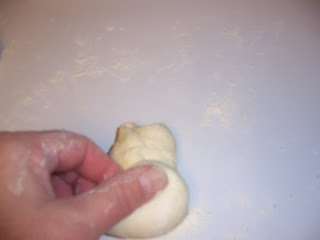I've really been looking forward to making this bread. I love that it has fresh rosemary in it. I started growing my own herbs this year in my container garden so it was particularly satisfying to be able to use fresh rosemary that I picked from my garden. Now, I just need to keep the herbs alive through the winter.
Potato Rosemary Bread
Makes: Two 1-pound loaves or 18 dinner rolls
Recipe can be found here
Paul, from Yumarama Artisan Bread Blog, made this bread a couple of weeks ago and posted a link to some helpful instructions from King Arthur Flour on how to roast a garlic for the most effective flavor and highest yield. You might enjoy these instructions as well.
Eventhough the formula states that the roasted garlic is optional, you don't want to skip it. The aroma is heavenly - not to mention the flavor it adds to the bread.
Making the Biga (refer to page 107)
For detailed instructions on making the biga, refer to the Italian Bread post. The potato rosemary loaves only use 7 ounces (or 1 1/4 cups) of the biga so you should have enough left over to make Pugliese, the next bread in the BBA Challenge.
Mixing the Dough
Remove the biga from the refrigerator 1 hour before you plan to make the bread and cut it into about 10 small pieces. Cover the pieces with plastic wrap and let them sit to take off the chill.
Stir (or mix) together the flour, salt, black pepper, and yeast. Add the biga pieces, mashed potatoes, oil, rosemary, and water.
Stir this mixture for 1 minute, or until the ingredients form a ball. Add more water or flour as necessary.
Kneading the Dough
Transfer the dough to a counter sprinkled with flour and knead for about 10 minutes until the dough is soft and supple. It should be tacky but not sticky.
Flatten the dough and spread the roasted garlic over the top.
Gather the dough into a ball, dust with a little flour and knead it by hand for 1 minute.
Fermenting the Dough
Lightly oil a large bowl and transfer the dough to the bowl. Roll it around to coat it with oil. Cover the bowl with plastic wrap.
Ferment the dough at room temperature for about 2 hours, or until the dough doubles in size.
Shaping the Loaves
Remove the dough and divide it into 2 equal pieces if you're making loaves or 18 equal pieces if you want to make dinner rolls. I opted to make two yummy loaves.
Shape each piece into a boule (refer to page 72).
Line a baking sheet with parchment paper and sprinkle with cornmeal. Place the dough on the parchment and make sure the boules are separated so they will not touch even after they rise.
Proofing the Loaves
Mist the dough with spray oil and cover loosely with plastic wrap. Proof at room temperature for 1 to 2 hours, or until the dough doubles in size.
Baking the Loaves
Preheat the oven to 400 degrees with the oven rack on the middle shelf. Remove the plastic wrap and lightly brush the loaves with olive oil. You don't need to score the loaves but you can if you like. I decided to score one loaf and leave the other unscored just to see the difference.
Place the pan in the oven and bake the loaves for 20 minutes, then rotate the pan 180 degrees for even baking. It will take about 35 to 45 minutes to bake the loaves completely.
If the loaves are fully colored but appear to be too soft, turn the oven off and let them bake an additional 5 to 10 minutes longer to firm up. My loaves were browning a little too soon so I turned the oven off. It worked great!
Remove the finished loaves from the oven and let them cool on a wire rack for at least 1 hour before serving.
This is the hard part. These loaves smell so good you want to eat them right away. However, my taste tester and I refrained from eating them before they cooled. We decided to go see some Christmas lights while we were waiting on the loaves to cool.
When we got back, the loaves were ready to eat. We dipped them in olive oil with freshly ground black pepper. Mmmmm....delicious!
Thanks for joining us this week in the Bread Baker's Apprentice Challenge. The next bread in Bread Baker's Apprentice Challenge is Pugliese (page 222 in the Bread Baker's Apprentice.). This bread also uses a biga and mashed potatoes.
Happy Baking!
Cathy























































